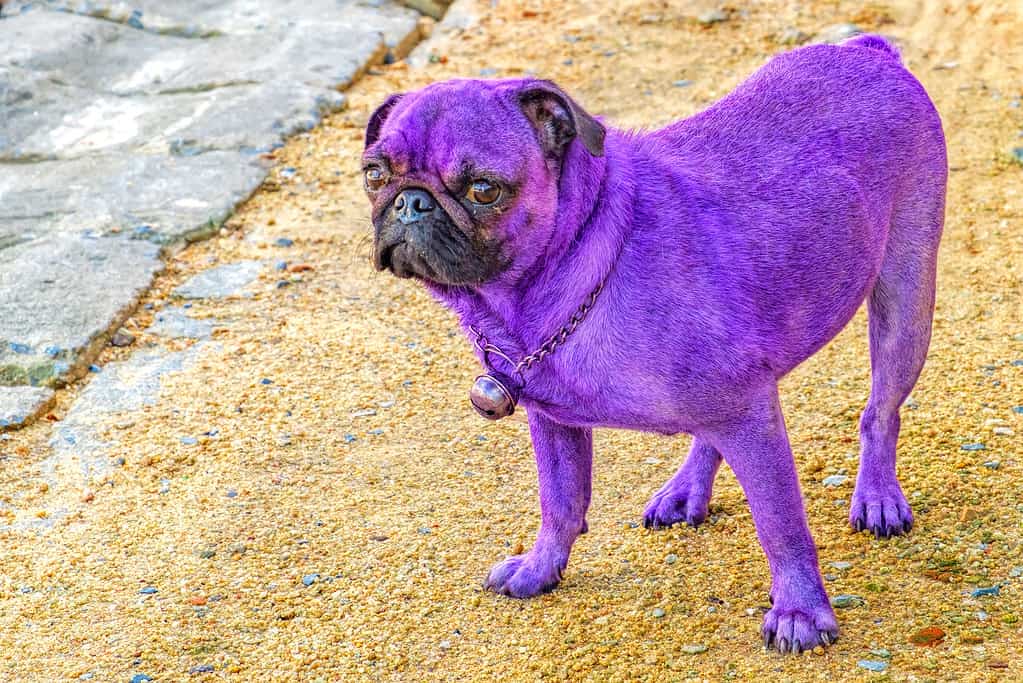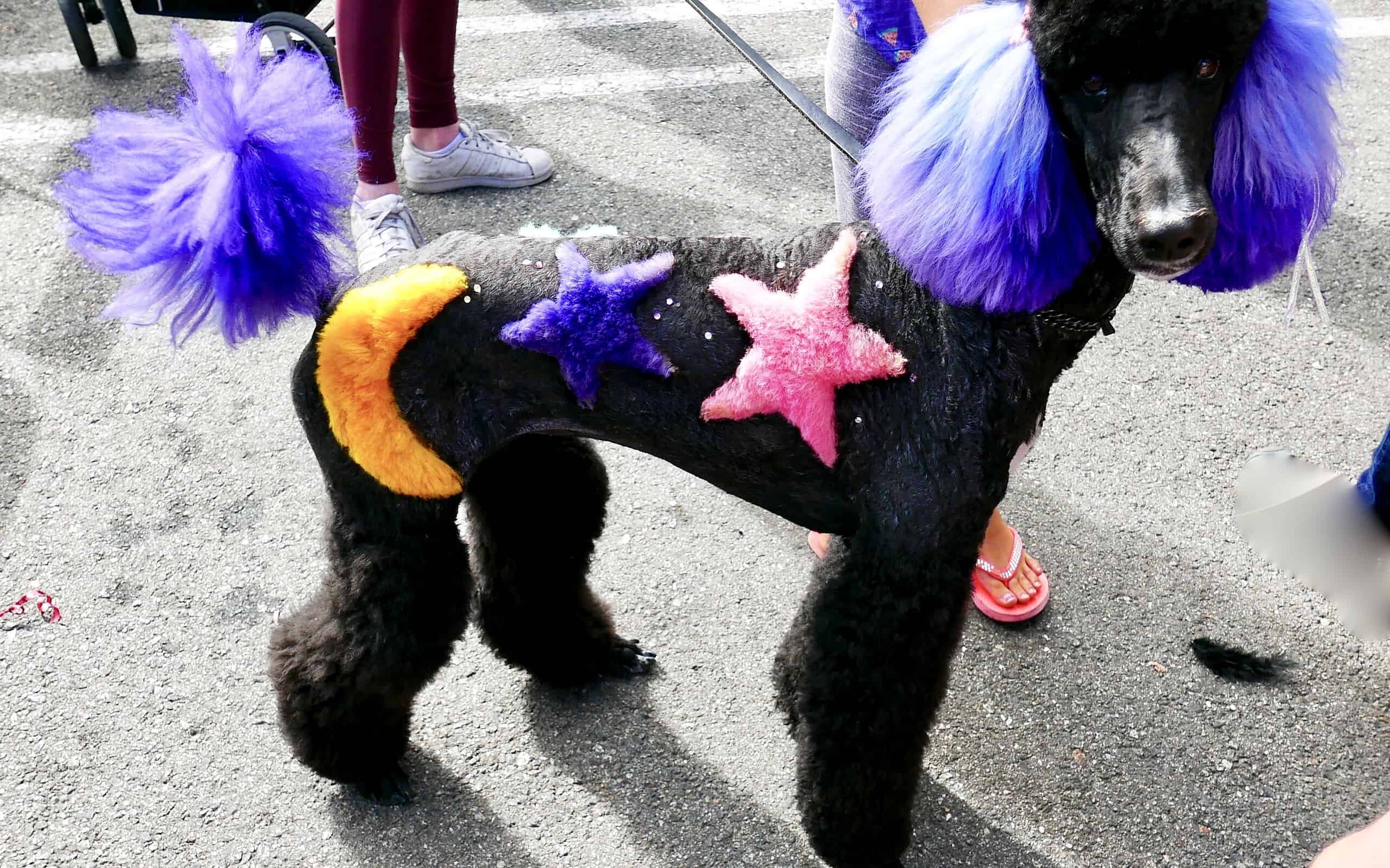People seem to have very strong opinions on dying a dog’s hair. There’s everything from competitive grooming competitions where poodles are dyed into entirely different creatures to pups with pops of color to celebrate various holidays and events. Some think it’s adorable, fun, and a great way to bond with your dog. On the other end, some are concerned it harms the animal. But if you want to add a little color to your canine, you don’t have to be a professional groomer or be unsafe. Read on for steps to follow and safety tips for dog hair dye. Remember, it’s worth going to a professional groomer if you are attempting a larger dye job or feel you need more guidance.
Make Sure Dye Is Allowed Where You Live

Four states make it a misdemeanor to dye your dog.
©sonatali/iStock via Getty Images
Some states have banned animal dyes! Colorado, Florida, Maine, and South Carolina all make it a misdemeanor or subject to fines if your dog’s fur has color. So thoroughly research local laws before you begin!
Only Use Dog-Friendly Hair Dye
Never use a dye or color meant for human hair. Dr. Rachel Davis, a veterinarian in New York, says, “Human hair dye contains toxic ingredients for dogs, such as ammonia, peroxide, and paraphenylenediamine. These chemicals can irritate your dog’s skin, eyes, and respiratory system, and can also damage their fur and cause hair loss.”
Visit your local pet store to see what types of dye they may carry specially formulated for dogs. They should all be non-toxic and free of harmful chemicals. There’s an array of the kinds on the market, including sprays, gels, and chalks; you can typically find numerous shades and colors and even glow-in-the-dark or glitter. Pet-friendly dyes are typically easy to apply and wash off and should be safe for your dog’s skin and fur. However, you should read the instructions and ingredients carefully before using them. Davis recommends a patch test on a small area of your dog’s fur to check for allergic reactions.
Try Food Coloring
Another option for temporarily dying your dog’s fur is food coloring. Davis recommends looking for natural versions in grocery stores or online. Mix them with water to create a paste or liquid. Some common colors to try are red (from beetroot), yellow (from turmeric), green (from spinach), blue (from blueberries), and purple (from purple cabbage). Do not let your dog lick or drink the food coloring or dye.
Make Your Own Dye out of Food
You can also create your own dye with foods safe for dogs to eat. “You can use foods that have a strong color or pigment, such as strawberries, carrots, pumpkin, or ketchup. Mash or blend these foods to create a paste or a liquid solution, and apply them to your dog’s fur,” Davis says. Be careful not to use foods that are toxic for dogs, such as chocolate, grapes, raisins, onions, garlic, or xylitol.
Check Your Dog Before Using Dye

Dog hair dye works best on a clean, dry dog without skin wounds or sensitivities.
©yanmiao/iStock via Getty Images
Before you go ahead and dye your dog, please give them a thorough once-over. If your dog has any wounds, skin irritations, or allergies, dying can make it much worse. It may even lead to inflammation, bleeding, or scarring. Dyeing can also introduce bacteria or fungi into the wound, causing infection or sepsis. Finally, dying can trigger an allergic reaction that can cause hives, swelling, redness, or itching on the skin. So, if you start to see any reaction, stop immediately and consult your veterinarian.
Before You Dye, Wash Your Dog
Cleaning your dog’s fur with shampoo and drying it thoroughly before applying the dye will help you remove any dirt, oil, or residue and will help make the dye adhere better and last longer. Rinse your dog well and dry them entirely since wet fur may dilute the color or cause it to bleed.
Protect Delicate Areas on Your Dog
Protecting your dog’s eyes with ointment or goggles will help you prevent any dye from getting into your dog’s eyes, which can cause irritation, inflammation, or infection. You should apply a thin layer of ointment or petroleum jelly around your dog’s eyes or use a pair of goggles that fit your dog’s size and shape. “You should also avoid dying your dog’s eyelashes or eyebrows, as this can interfere with their vision and make them uncomfortable,” Davis says.
Apply the Dye Carefully
Use a brush and spray bottle, or dip your dog in a tub of colored water to distribute the dye evenly and thoroughly on their fur. You can choose the best method for you and your dog, depending on the type of dye you use and the coverage you want. Always use a clean brush or spray bottle that is dedicated to this purpose only. Additionally, avoid using metal utensils that may react with the dye. It would be best to use gloves to protect your hands from staining.
Finally, be careful not to get any dye in your dog’s mouth or nose, which can cause nausea, vomiting, diarrhea, or choking. If this happens, you should rinse your dog’s mouth or nose with water immediately and contact your veterinarian if needed, Davis advises.
Let the Dye Sit
Letting the dye sit for about 15 to 30 minutes, depending on the intensity of the color you want, will help the color set and last longer. Follow the instructions of the product that you are using and check the recommended time. Try to keep your dog calm and comfortable during this time, as moving around or scratching can ruin the color or cause irritation. Try distracting your dog with toys or treats!
Final Steps
Rinse your dog with warm water until the water runs clear. Avoid rewashing your dog, as it may strip the color. Check your dog’s eyes, ears, nose, and mouth for any dye residue, and rinse it well. Finally, thoroughly dry with a towel or a blow dryer to prevent color bleeding or staining on your furniture, clothes, or other surfaces. Dying your dog’s fur should be a fun and rewarding experience for both of you. These steps and safety tips for dog hair dye should make the job easier, but consult your veterinarian if you have any questions.
Ready to discover the top 10 cutest dog breeds in the entire world?
How about the fastest dogs, the largest dogs and those that are -- quite frankly -- just the kindest dogs on the planet? Each day, AZ Animals sends out lists just like this to our thousands of email subscribers. And the best part? It's FREE. Join today by entering your email below.
Thank you for reading! Have some feedback for us? Contact the AZ Animals editorial team.








